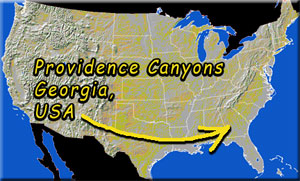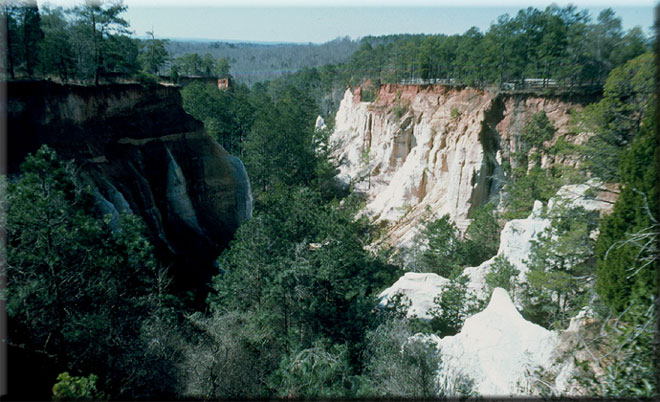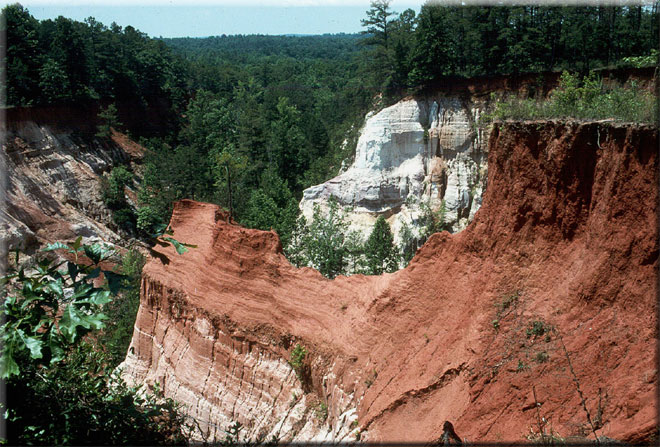|
 Georgia's Hidden Canyonsby Willis T. Bird
There are mountains in northern Georgia, but for the most part the south is flat farmlands. Rolling hills with pine forests are everywhere, but nothing one could call a mountain. So when you come to a place in west central Georgia that is affectionately called The Little Grand Canyon, you may be a bit suspect. I know I was.
I have lived in southern Georgia (Columbus) and spent much time hitting the back roads when my wife and I used to do a lot of sports car rallying. Many times we had no idea where we were as we followed the written directions trying not to make any errors. But we saw a lot of very new and interesting country as we ran in these rallies. Eventually we began planning them and that entailed finding interesting and less traveled roads in an area. Often we looked for unpaved roads. Even when we stopped rallying - sometime in the seventies as the first gas crunches hit - we still loved to go exploring when we could. We love the back roads because you never know what you will see there. It was around this time we found out about this place near Lumpkin, Georgia, called Providence Canyons. It also had the presumptive name of Little Grand Canyon by folks native to the area. It is not a place you will happen upon by chance - you have to be digging deep into the area. I think we found it while visiting another interesting spot very close to the Canyon - Westville "Where it is always in the 1800s." You can visit Westville the same day you go to the canyons. Providence Canyons is just a few miles to the west of Westville, and as a state park, charges a modest fee to enter. It covers over a thousand acres and has two picnic shelters, one group shelter, and some Pioneer Camps. If you wish to use these facilities you can reserve them by calling (800) 864-7275.
 Being a flatlander myself, I was amazed the first time I laid eyes on this unique formation. At first it looks much like the other pine and hardwood country surrounding it. Then you come to a place where you can park. There are viewing telescopes next to a small rail fence that you may use. As you walk toward the telescopes, a beautiful vista opens before and beneath you. After the initial surprise, you will notice the vast array of colors in the sands that make up the formations below you. From what I am told, this once was an underwater ocean bed and the various layers of sand were put down eons ago. The canyon was created by erosion as most canyons of this type are, but this time it was started by man and his poor use of land management. There is an interpretive center at the end of the road into the Canyon Park. There you will find restrooms, information, a small museum, and a video theater telling how the canyons were formed. You can hike to the bottom of the canyon using trails provided. My wife and I did this when younger but my legs will no longer allow it so I do not know how it appears in recent years. I say that because as rains fall, the canyons change. There used to be a large arch below but I understand that it is no longer there. However, the canyon is always beautiful and colorful. If you have youngsters with you, you should keep them well in hand as it is easily possible to fall from the edge down into the canyon if care is not used. You must also keep an eye out for the occasional rattlesnake. I saw one very large one located next to one of the trails. They will usually let you know that they are around with their rattles but it is best to keep your eyes open.
 On occasion they have interpretive raptor shows there. If you are lucky enough to be there when they are displaying these beautiful birds of prey, be sure to take advantage of the occasion and get some candid shots of some magnificent birds. Directions: Take U.S. 27 south from Columbus, Georgia to Lumpkin, Georgia. Providence Canyons State Park is located 7 miles west of Lumpkin on Georgia Hwy. 39C. It is marked with a State Park sign. This is definitely worth the trip and if you like hiking, the trip down into the canyon will make a memorable experience. Take your camera. Bug spray in the summer will help too. In the South, bugs are a way of life.
Further Information: Willis T. Bird is a retired government worker (State and Federal) and has been a serious photographer for 40 years. He has written and published a Sci-Fi novel, "The Alaska Incident" as well as a feature article for "Florida Game & Fish" magazine. He is the author of a series of articles on photography for young people at www.apogeephoto.com under the heading of "First Class Photography". Willis served in the USAF as an intercept radio operator and has been a amateur radio operator for 53 years. His first love is wildlife and landscape photography. You can contact him at wbird@centurytel.net
© Willis T. Bird, 2006
Be informed when this site is updated: |